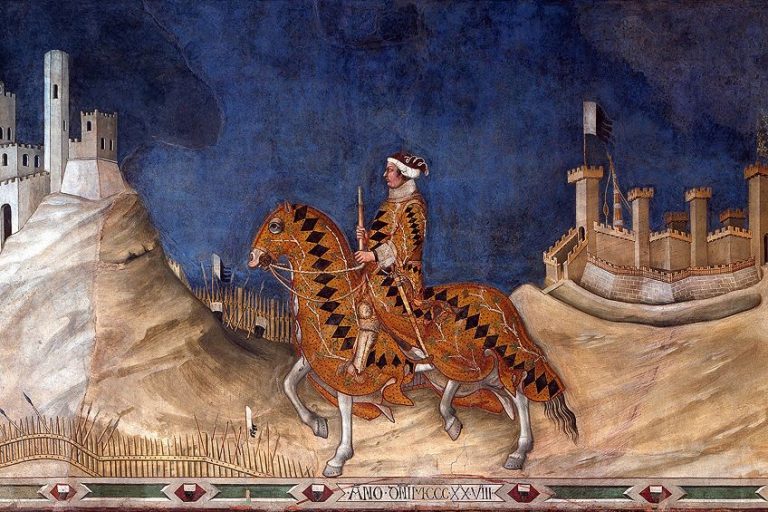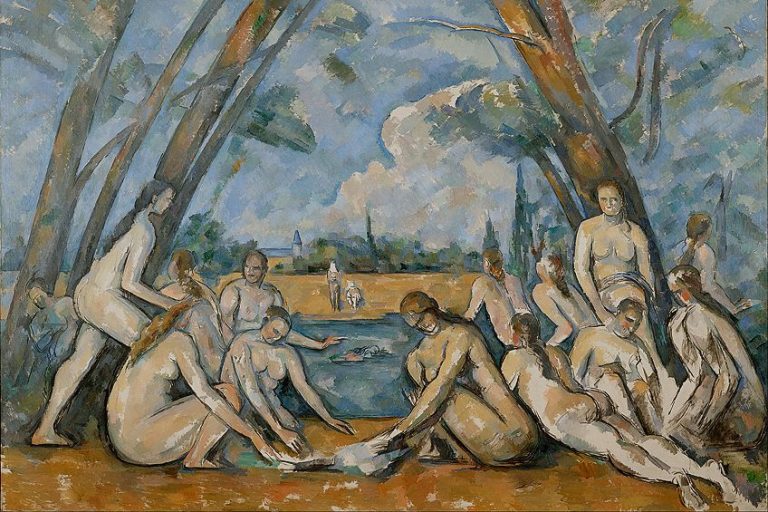Still Life Painting – History of the Object Painting Genre
Still Life painting developed as an art genre from the earliest centuries during the Egyptian and Roman periods. The history of the object can be tracked in many still lifes, from fruits, vegetables, skulls, and goblets. This article will explore the history of Still Life and famous Still Life paintings.
Table of Contents
Freedom of Choice: What Is a Still Life?
Before we look at the history of Still Life or even famous Still Life paintings, it is important to understand and ask the question: what is a Still Life? For many it might seem like a dull genre of painting: a mere bowl of fruit, flowers, or kitchen utensils arranged in a neat manner on a table or any other surface, but this is exactly what a Still Life is.
A Still Life is composed of a variety of both animate and inanimate objects, such as utensils, foliage, and food (anything from man-made to natural), which are then arranged by the artist in a unique way.
The diversity of arrangements and objects to choose from are vast, which makes this genre of painting anything but dull. This style of painting also gives artists significant freedom of choice. Artists can choose how to paint a still life in terms of what the palette of colors are, the ambiance of the composition, as well as its size.
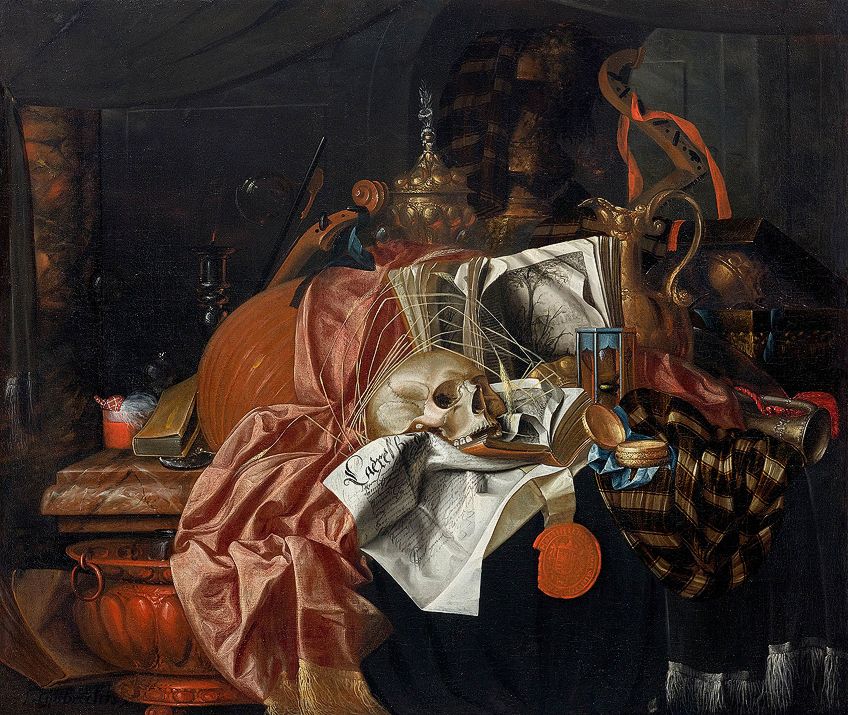
Still Life Definition
The term “Still Life” was officially used to name a genre around the late 1500s into the 1600s (16th and 17th Century) in the Netherlands. It is translated from the Dutch word stilleven. In French, the term for Still Life is nature morte, which means “dead nature”. In Italian, it translates to natura morta, which also means “dead nature”.
The very definition of still life then alludes to something without life, without movement – an inanimate object.
History of Still Life Painting
Still Life art has its origins in as early as Egyptian and Roman times. It was also prevalent during the Middle Ages and Renaissance Era, but officially became a genre of painting after these periods within visual arts history. Still Life as an official genre falls among the lower tiers of the hierarchy of visual art genres. There are also different styles of Still Life painting, but let us first discuss the hierarchy of genres and situate Still Life within this for more context.

Academic Art and the Hierarchy of Genres
In 1669, the historiographer, André Félibien, who was in the French Academy, provided a succinct categorization for the different styles of visual arts. Other academies included the Academy of Art in Rome and Florence, as well as the Royal Academy in London and the aforementioned French Academy.
The categories were ranked from highest to lowest, starting with History Painting, Portraiture, Genre Painting, Landscapes, and lastly Still Life. The categories, otherwise referred to as ranking systems, were designed to distinguish between different artworks and their monetary value, as well as qualify for exhibition spaces and art prizes.
During this time in European history, the ranking system for paintings came from the Academic art movement, which sought to educate artists according to artistic principles and to distinguish between art and art done as a craft.
One of the main aims of Academic art was that art needs to share a message, more so a moral message. This was measured by the types of paintings created, for example, the History Painting genre was better able to convey a moral message than a Still Life painting genre.
This was because history paintings, for example, were larger in size and utilized within a public space while still life paintings were created as smaller paintings for personal use. Furthermore, history paintings had more scope to portray religious narratives where still life paintings seemed more limited to a particular subject matter.
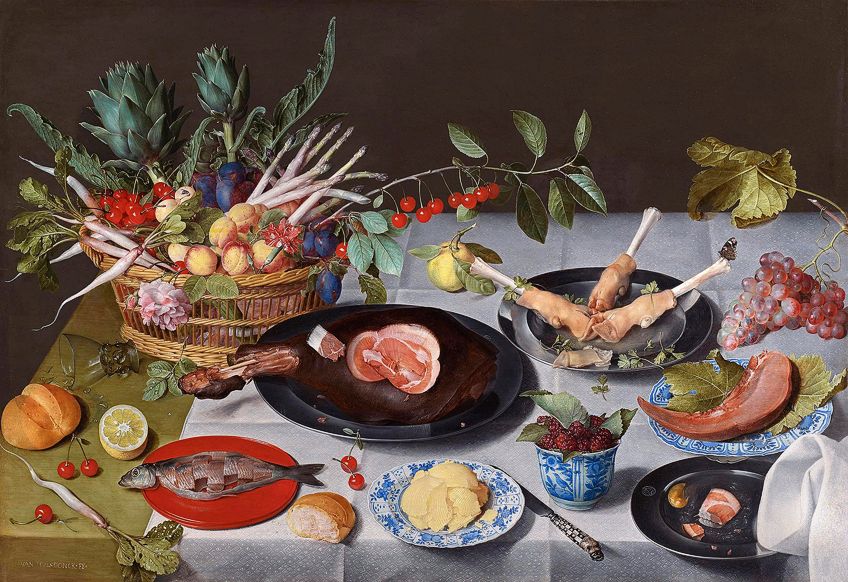
What Is a Still Life?
There are various types of still life paintings, which are referred to as “pieces” and fall within the following categories: “flowers”, “banquet or breakfast”, “animal”, and “symbolic”. Within the symbolic category, we also see the popular Vanitas Still Life, which made use of various objects to convey a deeper message about life and death.
The term vanitas means “vanity” in Latin and relates the message that life is short and the attachment to materiality is a vain attempt. The term is also derived from the Bible’s Ecclesiastes verse that states: “Vanity of vanities, everything is vanity”. Objects would symbolize these above principles.
Some of the more popular items we see in Vanitas Still Life paintings are skulls, watches, hourglasses, to name a few – all suggestive of the passing of time and life, in other words, the transitory nature of life. Other objects utilized would convey materiality and the accruing of wealth and attachments to earthly desires, or pleasures like dice, wine, fabrics, jewelry, gold, among many others.
The Unofficial Still Life Paintings: From Ancient to Classical Antiquity
Still Life paintings in ancient Egyptian tombs consisted of common foods and objects, although they held deeper meanings than being mere tombstone decorations. The still life depictions were in honor of the dead and their usage in the afterlife. For example, a bowl of food would be included so that the person would have something to eat in the afterlife.

The Tomb of Menna, also referred to as TT69 (Theban Tomb 69), is a well-known Egyptian tombstone. It houses a rich and well-preserved display of Still Life paintings as well as depictions of day-to-day living and funerary rituals. It is believed to be the burial site of Menna, who was an official to the King and “Overseer” of agricultural occupations.
We also find Still Life paintings in classical antiquity, during the Greek and Roman periods. During the archaeological excavations in areas like Pompeii and Herculaneum, various Roman villas were discovered depicting Still Life paintings as frescoes and mosaics.
These depictions appeared more decorative compared to ancient Egyptian art, and illustrated how people indulged in the joys of daily life. It also often depicted the lavishness of the homeowner.
One example is the Still Life with Glass Bowl of Fruit and Vases (c. 63 to 79 CE), discovered in Pompeii. Other examples even allude to Still Life already functioning as an art genre and decorative painting style during the Greek times. This originates from the legend of two Greek painters, Zeuxis and Parrhasius, who competed with one another in painting.

The Roman philosopher and writer, Pliny the Elder, also mentioned a Greek painter called Peiraikos. He wrote about the artist’s success as the top painter in his genre in his publication Natural History (78 CE). He wrote about Peiraikos’ subject matter as consisting of “barbers’ shops, cobblers’ stalls, asses, eatables, and similar subjects”. He continued to describe the painter as a “rhyparographos”, a “painter of dirt/low things”.
Renaissance Still Life
During the Middle Ages and into the Early Renaissance period, Still Life painting accompanied religious artworks as supplementary stylistic elements with symbolic meanings. These were usually painted in the backgrounds of religious paintings as well as on other artistic works like illuminated manuscripts, which were seen in Northern Renaissance and Early Netherlandish paintings.
There was a primary focus on the role of the Still Life within a religious context. This is evident in the works of the Flemish painter, Jan van Eyck, where his paintings are coupled with what is referred to as “iconographic” paintings.
Other artists like Leonardo da Vinci and the German painter Albrecht Dürer painted Still Lifes without religious symbolism. For example, Still Life paintings were done of various natural objects of fauna and flora. At this stage, Renaissance still life paintings were also done to explore the natural world by observing it and then painting it.
Dutch Still Life
Still Life painting started as a genre in the Netherlands, or what was termed as the Low Countries, which comprised of Belgica, Flanders, and the Netherlands. The Dutch Golden Age was a result of Dutch independence from Spain, which led to the Dutch Republic being born. Still Life was especially prominent as a painting style during this time, especially paintings of flowers.
The Protestant Revolution also minimized the production of religious artworks, which led the way for other types of genres of painting to be explored. Still Life paintings were favored because they depicted the everyday scenes of people and their lives and had inherent symbolic meanings from various objects. This branched into what was called “Dutch Realism”.

Dutch Realism focused on the ordinary depictions of people, specifically the middle class, which consisted of traders and merchants. When it came to painting, artists painted subject matter for merchants who were more focused on depicting what they have earned in life. Other popular painting genres were portrait and genre paintings of everyday people and their skills and various embellishments.
Paintings during this period were also small and done for private home display as opposed to paintings done on larger scales for churches or altarpieces, as was common for the Catholic Church.
However, because this was dominantly a Protestant culture, there was not a need to flaunt artworks in the same way. Furthermore, the common types of Still Life paintings, or sub-sets, included the aforementioned Vanitas genre, Ontbijtjes (which translates to “breakfast pieces”), Pronkstilleven (which translates to “ornate”), or “ostentatious” displays of Still Life pieces, as well as florals.
Modern Still Life
Modern Still Life prevailed during art movements like Impressionism and Post-Impressionism. Notably, during Post-Impressionism, Vincent van Gogh brought Still Life painting to life with his expressive and flower and vase paintings. An example of this includes his piece, Sunflowers (1889).
A French artist from Post-Impressionism, Paul Cézanne, painted Still Lifes with fruit, bread, bottles, and baskets atop a seemingly toppling table, as in The Basket of Apples (c. 1895). The difference between these paintings and the more realistic Dutch Still Life paintings was that these modern artists used more expressive brushstrokes, colors, and different perspectives.
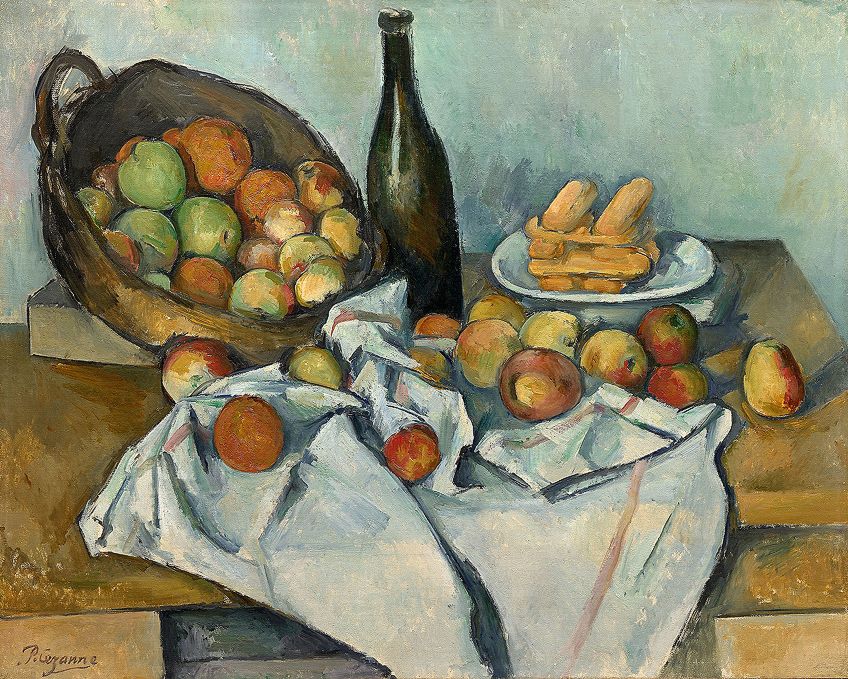
Cézanne also incorporated familiar elements that we find from the Dutch Vanitas era, for example, the characteristic skull in his work titled Still Life with Skull (c. 1895 to 1900). Accompanying the skull on another seemingly toppling tabletop are various fruits, one of them with a piece either cut or bitten out of it, placed directly in front of the skull’s mouth.
During the Cubist art movement, popular artists like Pablo Picasso and Georges Braque created Still Life paintings in their characteristic abstract and cubic style. An example of this is in Picasso’s Large Still Life (1881 to 1973) and Braque’s Still Life with Metronome (1909).
In contemporary Still Life art, we find photography, computers, and videos as a means of portraying everyday objects and food. The evolution of technology has allowed a hyper-realistic portrayal of subject matter, from painting to beeing computer-generated. The canvas of Still Life art has evolved dramatically into the 21st Century.
Famous Still Life Artists
Still Life art is a vast and diverse genre of painting, with many great artists depicting their unique styles and subject matter. Below, we look at some of the prominent names within this painting style and some of their famous Still Life paintings.
Jan Bruegel the Elder (1568 – 1625)
Jan Bruegel, a Flemish painter born in Brussels, was a leading artist in the Still Life genre. He specialized in floral paintings and was known by the nickname “Flower” because of his vast experience and occupation with floral Still Lifes. He also specialized in paradisal landscape paintings.
One of his famous paintings includes Flowers in a Wooden Vessel (1606 to 1607), which depicts an elaborate display of various types of flowers. Bruegel took great care here to depict each flower without it being in front or behind another flower. We can see the fine detailing of each flower.

The flowers in the foreground are highlighted against the dark background of the painting, giving them more prominence. We also notice an assortment of flowers strewn on the tabletop, making the composition appear more natural.
Other works include Flowers in a Ceramic Vase (c. 1620), which appears similar to the abovementioned painting, however, Bruegel managed to depict each painting uniquely despite the subject matter being the same. Here again, we see a colorful assortment of different flowers arranged delicately as if by hand. Interestingly, Bruegel often painted flowers from different seasons, which suggests that he did not paint from an actual model of flowers in a vase.

Frans Snyders (1579-1657)
Frans Snyders was born in Antwerp and is known as one of the pioneers of Flemish Baroque art. He specialized in Still Life paintings with different subject matter, with a special focus on a range of animals like poultry, monkeys, hares, birds, and dogs, among others. He also painted hunting and market scenes.
His paintings are diverse in their composition with a keen eye for detail of different objects and textures.
One of his famous paintings is Pantry Scene with a Page (1579 to 1657), which depicts a page on the left of the composition picking a grape from a bunch of fruit on a stand. We also notice various other foodstuffs like a large shrimp, a boar’s head in the top right corner, and other dead animals.

This composition depicts the page taking from an elaborate selection of food, a richness of nourishment. This is suggestive of the opulence of life as well as of luxury and being tempted by it. Additionally, the dead animals also suggest the shortness of life and that material goods are not sufficient.
Other works by Snyders include Wild Boar Hunt (1649), Still Life with a Swan (1613), and Still Life with Dead Game, Fruits, and Vegetables in a Market (1614). The latter painting is a dynamic portrayal of different kinds of dead animals, fruit and vegetables in baskets, and kitchen utensils. We see a gentleman standing to the left of the painting holding a basket of food in his right arm while tipping his hat with his left hand, seemingly oblivious of the boy pickpocketing him.
In the forefront of the composition, we notice a black cat with a focused gaze on two cocks in a squabble. This further adds to the dynamism of the scene, including the live human figures combined with the still life objects. He was also influenced by the Flemish painter Peter Paul Rubens, whom he also worked with on various projects.
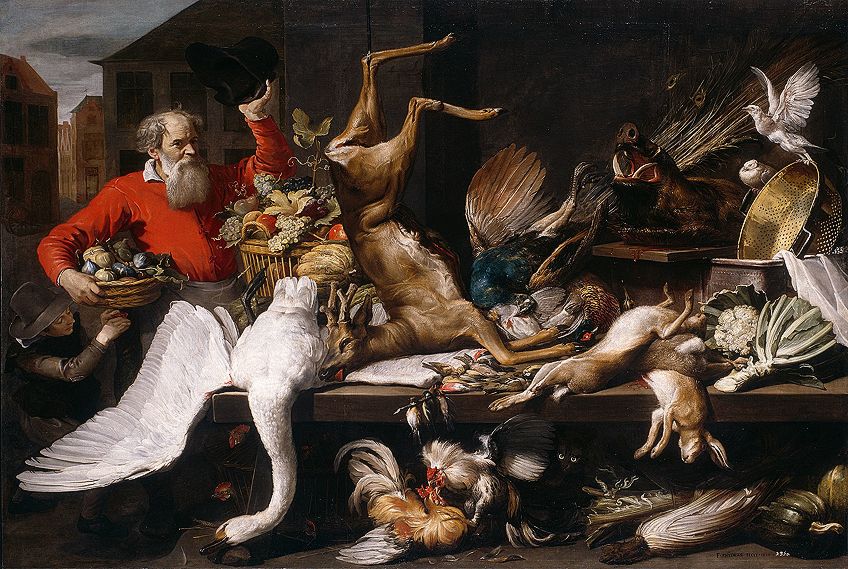
Willem Claesz Heda (1594–1680)
Willem Claesz Heda was born in Haarlem in the Netherlands and was one of the leading painters only engaged in Still Life paintings. He primarily specialized in “breakfast pieces” (ontbijtjes). He is well-known for his fine attention to detail as well as his rendering of light in how he utilized colors. His works have a heightened sense of naturalism, almost inviting us to touch each object as if it were real.
We will notice his focus on subject matter like silverware and glass along with foods like oysters, hams, and mincemeat pies.
Some of his famous artworks include Breakfast Table with Blackberry Pie (1631), Still Life with Oysters, a Silver Tazza, and Glassware (1635), Still Life with Oysters, Rummer, Lemon and a Silver Bowl (1634), Still Life with Olives (1634), Still Life with Gilt Goblet (1635), Ham and Silverware (1649), and Still Life with Pie, Silver Ewer and Crab (1658).
When we look at Heda’s Breakfast Table with Blackberry Pie, we notice a table with a silken tablecloth draped over the left half of it as if it were specifically placed for the plates and glass cups on it for dining. The table is set for what appears to be two people, but only one plate has a piece of the blackberry pie, of which a part has been eaten. We also notice a spoon atop the main blueberry pie.

On the right side of the table, there is an overturned goblet, half of which is lying on another empty silver plate. There is also a glass goblet with liquid in it. Towards the left, there are two glasses, one overturned with a piece broken off, and one with liquid in it, possibly wine. The entire composition denotes a rather lavish scene in which someone has already dined or is in the process of dining.
In Still Life with a Gilt Cup (1635), we notice a similar table setting, this time with a beige tablecloth over half of the table, appearing as if it was a quick luncheon or snack. The central object on the table is a glass goblet. There are two silver plates, one with oysters and one with a lemon in the process of being peeled; the peel is draped over the edge of the table.
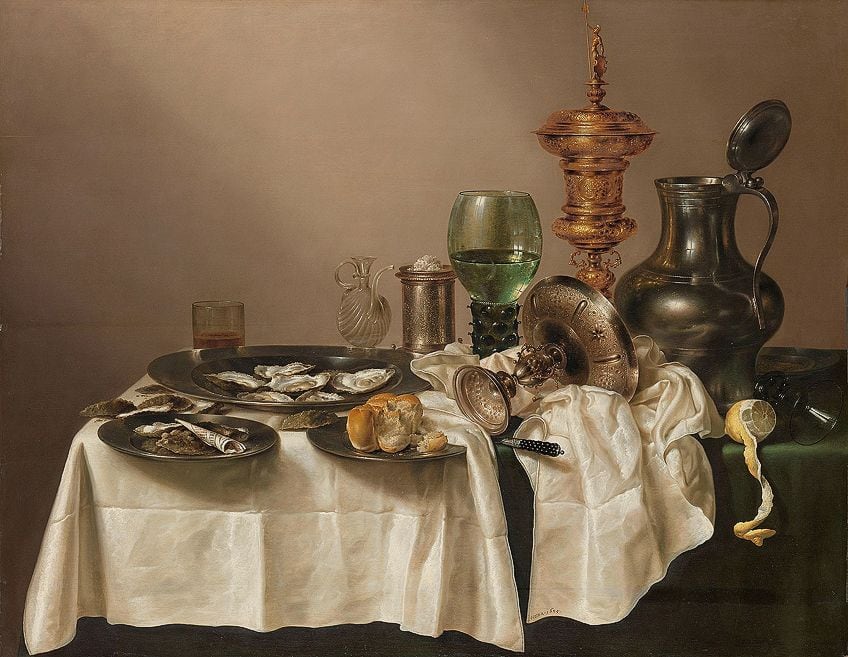
We also notice an overturned glass on the right of the table, suggesting this meal was or is in the process of being well enjoyed or merely just suggestive of an accident while dining. The scene, although a Still Life, suggests movement in that it appears that the action of dining is currently taking place. The composition appears darker in color and contrast, with an unknown light source emanating from the left.
While many of Heda’s Still Life paintings appear seemingly similar in their compositional layouts and subject matter, each one is unique in its own right because of the placement of objects and how they catch the light.
Pieter Claesz (1597–1661)
Pieter Claesz was born in Belgium in Berchem, and he was a peer of Heda’s. The two artists painted very similarly, often with monochromatic colors and an emphasis on light captured in a painting. Claesz explored the Ontbijtjes style, but also painted in the Vanitas style, giving his compositions an additional symbolic nature.
Some of Claesz famous artworks include Still Life with Musical Instruments (1623), Vanitas with Violin (1625), Vanitas Still Life with Spinario (1628), Still Life with Skull (1630), Still Life with Roemer, Crab and a Peeled Lemon (1643), Still Life with Fruit and Roemer (1644), Still Life with Salt Tub (1644), among others. In Still Life with Musical Instruments, we notice a large table with an array of foodstuffs and items, a cello and violin to the right, and a small accompanying table with two glass domes and a turtle on it in the foreground.
In Claesz’s Vanitas Still Life with Spinario we also notice the characteristic skull on a table alongside many other items including a large sculpture of a boy fiddling with his foot. This composition encompasses a bigger space, which appears to be a room of some sort, possibly a study due to the books, armor, and musical instruments strewn seemingly haphazardly on the floor.
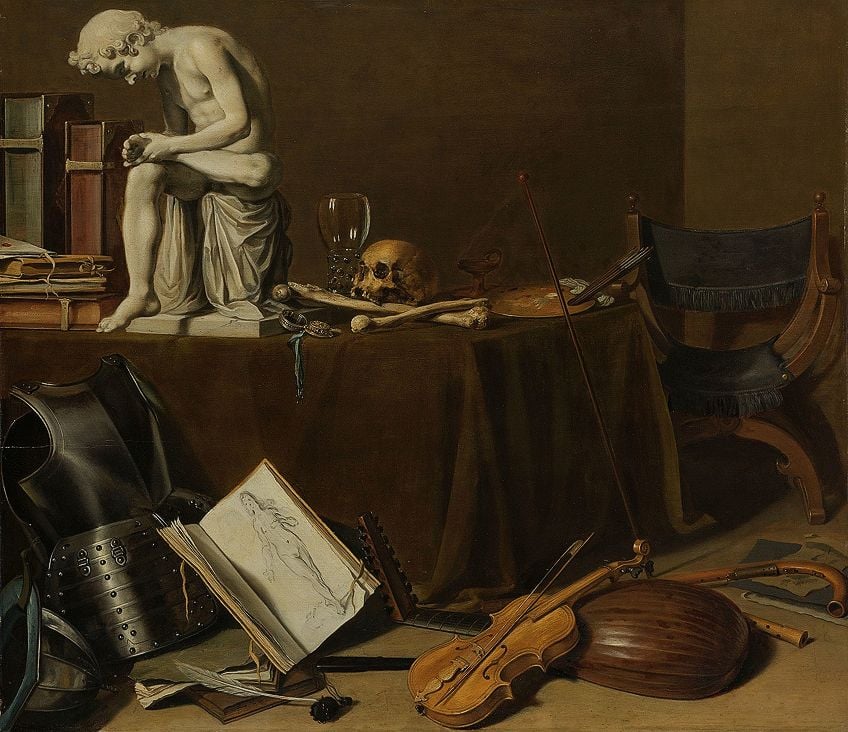
Willem Kalf (1619 – 1693)
Willem Kalf was born in Rotterdam in Amsterdam and was another popular Still Life artist who specialized in the style called Pronkstilleven. His work is characterized by the inclusion of Chinese porcelain bowls and jugs. We also notice keen attention to detail in his objects, which not only displays Kalf’s artistic skill but emphasizes the inherent symbolism of the composition.
This symbolism points to the transience of life, as well as the idea of lavishness.
This realism allows us to almost touch each object, relishing in its texture and colors. This is another important aspect of Kalf’s work – the way he works with color to depict light and the textures of each object to give it realism beyond the paint that creates it.
Some of Kalf’s famous artworks include Still Life with a Silver Ewer and a Porcelain Bowl (1660). Here, we see the familiar porcelain bowl tipped with fruit tumbling out of it. To the left is a resplendent silver ewer as the central object of the composition, coupled with an intricately designed golden goblet behind it.
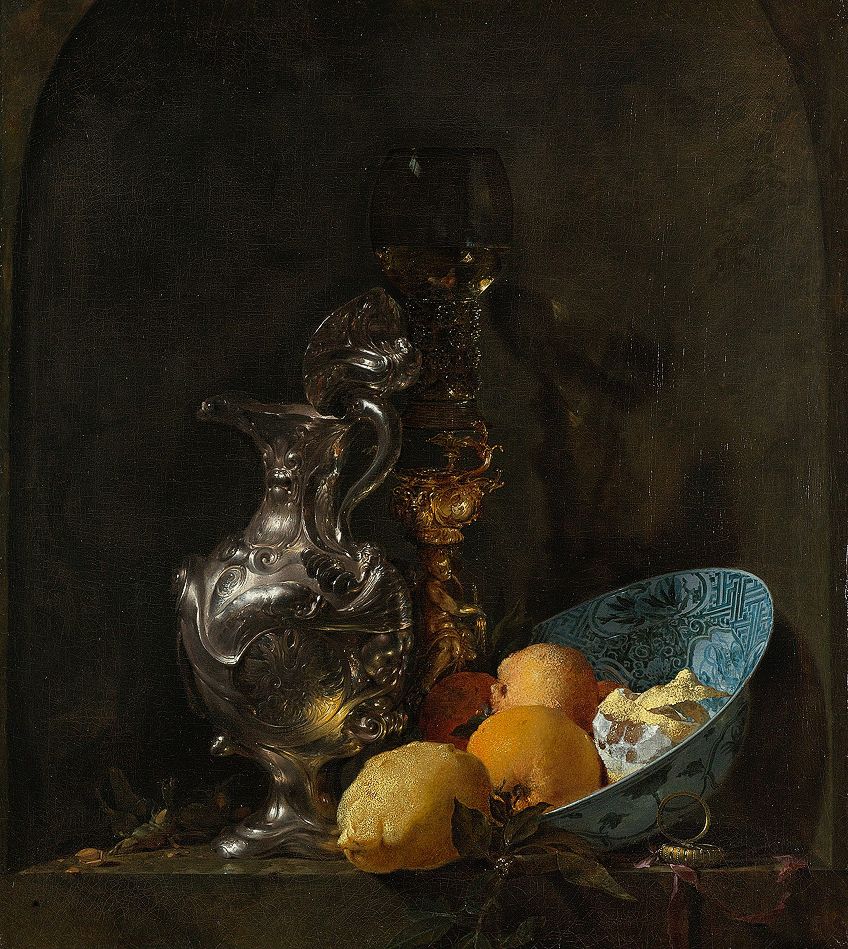
Some of the symbolic aspects of this painting are alluded to by the half-peeled, moldy lemon, which denotes time and decay. Additionally, there is a watch to the bottom right on the table, pointing to time and in turn, to the transcience of life. Conversely, the realism of each object suggests an engagement with our senses and the lavishness of enjoying food.
Other works by Kalf, which appear seemingly similar in composition, although each is unique in its portrayal, include Still Life with Drinking Horn (c. 1653) and Still Life (1660), which includes the characteristic porcelain vase and peeled lemon. Kalf also uses tapestries as tablecloths with a darker color palette.
However, the darker color palette still shows us how Kalf utilizes texture and light in his compositions. This is especially highlighted by how light reflects off the silverware, including the yellow of the lemon, evident in the silver ewer in the abovementioned painting.

Still Life: Still in the Game
The evolution and history of Still Life painting are as rich and vast as the fruits and meats it makes up. The role played by these various plates of foodstuffs and accompanying objects have been a testament to this unique artistic genre.
From ancient Egyptian tombs to Roman murals, from the realism of Dutch Vanitas to the hyper-realism of 21st Century photographs – all depicting inanimate objects – the nature of Still Life paintings occupies a place in the visual arts world without which we might be at a loss for appetite.
Take a look at our Still Life art webstory here!
Frequently Asked Questions
What Is a Still Life?
A Still Life is a painting composed of inanimate objects like kitchen utensils, foliage, food, dead animals, clocks, and musical instruments, among others. It is composed of anything from man-made to natural subject matter. These are all placed in different arrangements by the artist, sometimes for symbolic meanings and other times as art for art’s sake.
What Does “Still Life” Mean?
The Still Life definition comes from the Dutch word Still leven. In French, it is nature morte and in Italian, it is natura morta – both terms mean “dead nature”. This directly points to what a Still Life inherently is, which is an arrangement of inanimate objects, and often that of dead nature, like dead animals, foodstuffs that allude to time passing and thus rotting, as well as something that stands still, which can otherwise be considered “dead”.
What Are the Types of Still Lifes?
There are different categories of Still Life paintings, which are referred to as types. These types are also called “pieces” and are, namely, flowers and floral types, banquet or breakfast types, animal types, and symbolic types (known as Vanitas).
What Are Vanitas Paintings?
The Latin term Vanitas means “vanity”, which is a concept explored in these types of Still Life paintings. They symbolize the shortness of life through the depiction of skulls, clocks, and even half-peeled fruit, indicating decay and the element of rotting and dead animals (sometimes juxtaposed with live animals). The term also derives from the Bible’s Ecclesiastes verse, which states: “Vanity of vanities, everything is vanity”.
What Is the Plural Word for Still Life?
The word “Still Life” refers to a work of art. Although it uses the word “life” in it, it does not refer to a living entity such as a person. Because of this distinction, the noun “life” receives an “s” at the end and does not become what we would commonly call it in the plural form, “lives”.
Isabella studied at the University of Cape Town in South Africa and graduated with a Bachelor of Arts majoring in English Literature & Language and Psychology. Throughout her undergraduate years, she took Art History as an additional subject and absolutely loved it. Building on from her art history knowledge that began in high school, art has always been a particular area of fascination for her. From learning about artworks previously unknown to her, or sharpening her existing understanding of specific works, the ability to continue learning within this interesting sphere excites her greatly.
Her focal points of interest in art history encompass profiling specific artists and art movements, as it is these areas where she is able to really dig deep into the rich narrative of the art world. Additionally, she particularly enjoys exploring the different artistic styles of the 20th century, as well as the important impact that female artists have had on the development of art history.
Learn more about Isabella Meyer and the Art in Context Team.
Cite this Article
Isabella, Meyer, “Still Life Painting – History of the Object Painting Genre.” Art in Context. June 18, 2021. URL: https://artincontext.org/still-life-painting/
Meyer, I. (2021, 18 June). Still Life Painting – History of the Object Painting Genre. Art in Context. https://artincontext.org/still-life-painting/
Meyer, Isabella. “Still Life Painting – History of the Object Painting Genre.” Art in Context, June 18, 2021. https://artincontext.org/still-life-painting/.








